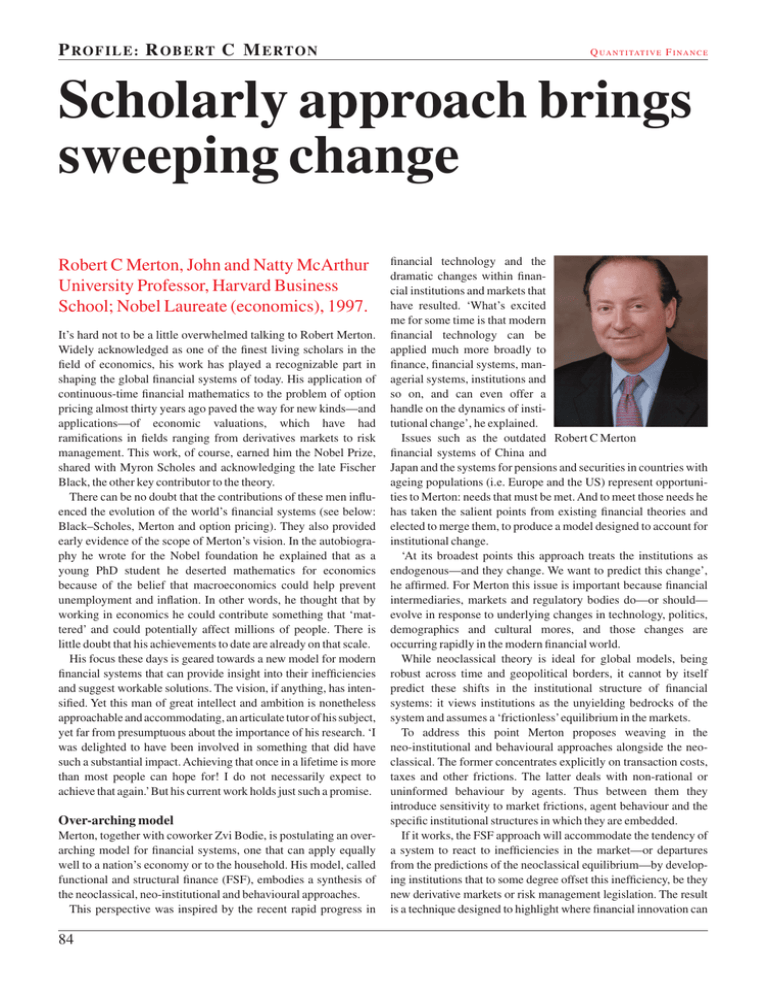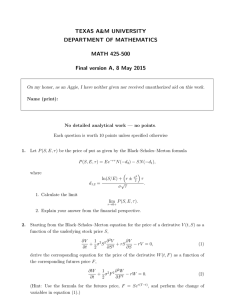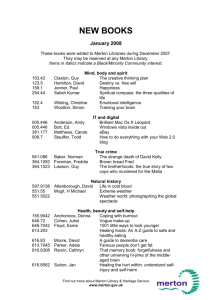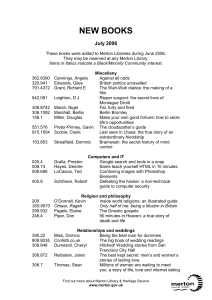P R C M RO F I L E :
advertisement

P ROFILE: R OBERT C M ERTON Q U A N T I TAT I V E F I N A N C E Scholarly approach brings sweeping change Robert C Merton, John and Natty McArthur University Professor, Harvard Business School; Nobel Laureate (economics), 1997. It’s hard not to be a little overwhelmed talking to Robert Merton. Widely acknowledged as one of the finest living scholars in the field of economics, his work has played a recognizable part in shaping the global financial systems of today. His application of continuous-time financial mathematics to the problem of option pricing almost thirty years ago paved the way for new kinds—and applications—of economic valuations, which have had ramifications in fields ranging from derivatives markets to risk management. This work, of course, earned him the Nobel Prize, shared with Myron Scholes and acknowledging the late Fischer Black, the other key contributor to the theory. There can be no doubt that the contributions of these men influenced the evolution of the world’s financial systems (see below: Black–Scholes, Merton and option pricing). They also provided early evidence of the scope of Merton’s vision. In the autobiography he wrote for the Nobel foundation he explained that as a young PhD student he deserted mathematics for economics because of the belief that macroeconomics could help prevent unemployment and inflation. In other words, he thought that by working in economics he could contribute something that ‘mattered’ and could potentially affect millions of people. There is little doubt that his achievements to date are already on that scale. His focus these days is geared towards a new model for modern financial systems that can provide insight into their inefficiencies and suggest workable solutions. The vision, if anything, has intensified. Yet this man of great intellect and ambition is nonetheless approachable and accommodating, an articulate tutor of his subject, yet far from presumptuous about the importance of his research. ‘I was delighted to have been involved in something that did have such a substantial impact. Achieving that once in a lifetime is more than most people can hope for! I do not necessarily expect to achieve that again.’But his current work holds just such a promise. Over-arching model Merton, together with coworker Zvi Bodie, is postulating an overarching model for financial systems, one that can apply equally well to a nation’s economy or to the household. His model, called functional and structural finance (FSF), embodies a synthesis of the neoclassical, neo-institutional and behavioural approaches. This perspective was inspired by the recent rapid progress in 84 financial technology and the dramatic changes within financial institutions and markets that have resulted. ‘What’s excited me for some time is that modern financial technology can be applied much more broadly to finance, financial systems, managerial systems, institutions and so on, and can even offer a handle on the dynamics of institutional change’, he explained. Issues such as the outdated Robert C Merton financial systems of China and Japan and the systems for pensions and securities in countries with ageing populations (i.e. Europe and the US) represent opportunities to Merton: needs that must be met. And to meet those needs he has taken the salient points from existing financial theories and elected to merge them, to produce a model designed to account for institutional change. ‘At its broadest points this approach treats the institutions as endogenous—and they change. We want to predict this change’, he affirmed. For Merton this issue is important because financial intermediaries, markets and regulatory bodies do—or should— evolve in response to underlying changes in technology, politics, demographics and cultural mores, and those changes are occurring rapidly in the modern financial world. While neoclassical theory is ideal for global models, being robust across time and geopolitical borders, it cannot by itself predict these shifts in the institutional structure of financial systems: it views institutions as the unyielding bedrocks of the system and assumes a ‘frictionless’ equilibrium in the markets. To address this point Merton proposes weaving in the neo-institutional and behavioural approaches alongside the neoclassical. The former concentrates explicitly on transaction costs, taxes and other frictions. The latter deals with non-rational or uninformed behaviour by agents. Thus between them they introduce sensitivity to market frictions, agent behaviour and the specific institutional structures in which they are embedded. If it works, the FSF approach will accommodate the tendency of a system to react to inefficiencies in the market—or departures from the predictions of the neoclassical equilibrium—by developing institutions that to some degree offset this inefficiency, be they new derivative markets or risk management legislation. The result is a technique designed to highlight where financial innovation can Q U A N T I TAT I V E F I N A N C E Black–Scholes, Merton and option pricing 1973 saw the publication of the Black–Scholes formula (see Black and Scholes 1973) for pricing stock options. This, for the first time, enabled option contracts to be effectively evaluated and priced on an open market. Merton’s influence on the formula was critical to its success. Previous work—by the legendary Paul Samuelson and others as well as Black and Scholes—had taken important steps towards a means of eliminating risk, but had failed to find a solution that ruled out arbitrage. When Merton came across Black and Scholes and their option pricing puzzle in 1969, while at MIT’s Sloan School of Management, he postulated that the limit of continuous trading was the only circumstance that would provide a riskless, hedged (zero-arbitrage) position on the option or stock. He then set about proving that this was so. A brilliant mathematical mind and earlier studies in portfolio theory, in which he developed the continuous-time model for capital asset pricing, stood him in perfect stead for this be used to effect positive change and improve financial efficiency. Merton is passionate about the value of financial innovation, if indifferent about the types of institution used to effect the change: ‘One of the implications [of the approach] is that institutions represent the selection of available tools in the financial toolbox. Idealogical differences of opinion—about which of these tools are best—need not come into it. I am an agnostic when it comes to making judgements between them—for example, between the public and the private sector. A priori, my view is that the appropriate mix will be the one that best performs the function required. There is no point in arguing over, for example, which is best—a hammer or a saw? Clearly the answer depends on the context of its use.’ The key to progress Sophisticated financial tools, meanwhile (such as derivatives— which he describes as the ‘financial adapters’ linking the systems of the world) are key to progress, he believes: ‘Instruments such as derivatives have taught us how we can decompose different things into different parts and reassemble them to do their jobs more efficiently. For example, you can now buy stocks, invest in futures, swaps and life insurance in a number of different ways. These instruments have had a profound effect on how the financial system has evolved and will evolve. In our theory we can use markets and instruments as more efficient ways of performing the central functions of finance.’ Financial innovation is linked to economic growth, observed Merton. ‘Which economies can take advantage of technological advance?’ he said. ‘Answer—the ones with a better financial system. Other work has already shown that the reason the industrial revolution took place in the UK and not France was because the UK had a well-developed system to support the financing and development of the technologies and the sharing of risk. ‘This factor may have important implications for priorities for developing countries—or developed countries, such as Japan. How can they improve their financial efficiency? Finding the answer to this will give us a pretty big kick. It might mean that P ROFILE: R OBERT C M ERTON challenging task. The result was a more general derivation of the formula, acknowledged in a footnote in Black and Scholes’ 1973 paper, which literally revolutionized modern financial theory. Merton later generalized it yet further and it is now applied to all sorts of option contracts and also to contingent claim contracts other than options. Before 1973, options markets were sparse and thinly traded. They are now among the largest and most active security markets. Investors and large corporations now use the Black–Scholes formula for planning, purchasing and pricing a variety of assets and fields such as risk management have matured on the basis of the method. Merton is still humbled by the honour of the Nobel prize. His father is the eminent sociologist Robert K Merton and a recipient of the National Medal of Science, so Merton grew up, he said, with an understanding of the significance of such accolades. He was surprised by the call that conveyed the good news. ‘I was on my way to catch a plane when I heard. I had to cancel my trip. It is such a singular honour, not comparable with anything else.’ some of them even leap-frog existing financial systems.’ His belief that progress is facilitated by financial innovation is coupled with a philosophical attitude to whether his theory will take root. The question whether FSF is intended to be predictive or prescriptive prompts the answer: ‘It doesn’t much matter’. The reason is that like all economists Merton solves for the best way of doing things—the system that maximizes economic efficiency. ‘My further theory is that what’s optimal generally finds its way into practice’, he added. ‘So I can apply this theory and use it in a predictive or forecasting manner on that assumption.’ What happens if that assumption is wrong, and the theory does not find its way into practice? ‘Well, then there are two possible explanations. (a)You’re wrong, and it wasn’t the best way of doing things. Or (b) it’s the best way but it’s not yet been implemented—but it should be. So then we decide to do it that way anyway. This is the prescriptive, or normative, approach. The fact is that we now have a wellenough developed bank of theories to feel confident about this.’ Merton’s enthusiasm—and his unshakable optimism—are almost tangible. He is still marvelling at the changes that have occurred in the last thirty years—since the widespread adoption of the Black–Scholes formula, to be precise—as well as the influence that academic endeavour has had and is having on the practising world and the increasing respect within the traditional sciences for financial science and engineering. ‘There was even a programme [in financial mathematics] at the Isaac Newton Institute [for Mathematical Sciences] at Cambridge. Just think about that.’ But more than anything his energies are directed towards the future. ‘We have a situation now in which there are real financial systems that need to be changed and we have the tools to do it. It’s a very exciting time.’ References Black F and Scholes M 1973 The pricing of options and corporate liabilities J. Political Economy 81 637–54 Vanessa Spedding 85




